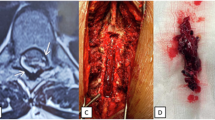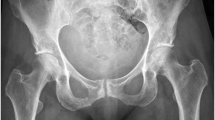Abstract
Study design:
Case report.
Objectives:
We report a case of a 75-year-old woman suffering from voluminous idiopathic spontaneous spinal epidural hematoma (SSEH) that was rapidly diagnosed and successfully treated.
Methods:
Clinical presentation was characterized by sudden and intense back pain that rapidly evolved into plegia of the right leg and severe paresis of the left leg. Hypoesthesia below T6 and urinary retention were also present. Magnetic resonance imaging showed a significant posterior spinal compression from T6 through L3 caused by an epidural hematoma that involved 10 metameric levels, extending for ∼20 cm, with a maximum thickness of 1.6 cm from T12 to L1.
Results:
Within 12 h, emergency decompressive laminectomy from T10 to L1 was performed, and evacuation of the hematoma was achieved. The postoperative course and neurological recovery of the patient were optimal. After discharge, the patient continued the rehabilitative treatment started during hospitalization, achieving an excellent functional outcome in 1 month.
Conclusions:
Spinal epidural hematoma (SEH) is a rare clinical finding that can occur following trauma or spontaneously (SSEH). We describe, to the best of our knowledge, the second most extensive idiopathic SSEH and the longest with involvement of the dorso-lumbar spine that had a excellent functional outcome due to emergency decompressive laminectomy, which is emphasized in the treatment of these rare pathologies.
Similar content being viewed by others
Log in or create a free account to read this content
Gain free access to this article, as well as selected content from this journal and more on nature.com
or
References
Jackson R . A case of spinal apoplexy. Lancet 1869; 2: 5–6.
Kreppel D, Antoniadis G, Seeling W . Spinal hematoma: a literature survey with meta-analysis of 613 patients. Neurosurg Rev 2003; 26: 1–49.
Lo C, Chen J, Lo Y, Lai P, Lin Y . Spontaneous spinal epidural hematoma: a case report and review of the literatures. Acta Neurol Taiwan 2012; 21: 31–34.
Lonjon MM, Paquis P, Chanalet S, Grellier P . Nontraumatic spinal epidural hematoma: report of four cases and review of literature. Neurosurgery 1997; 41: 483–487.
Groen RJ, van Alphen HA . Operative treatment of spontaneous spinal epidural hematomas: a study of the factors determining postoperative outcome. Neurosurgery 1996; 39: 494–5096.
Lawton MT, Porter RW, Heiserman JE, Jacobowitz R, Sonntag VK, Dickman CA . Surgical management of spinal epidural hematoma: relationship between surgical timing and neurological outcome. J Neurosurg 1995; 83: 1–7.
Zhong W, Chen H, You C, Li J, Liu Y, Huang S . Spontaneous spinal epidural hematoma. J Clin Neurosci 2011; 18: 1490–1494.
Shin JJ, Kuh SU, Cho YE . Surgical management of spontaneous spinal epidural hematoma. Eur Spine J 2006; 15: 998–1004.
Author information
Authors and Affiliations
Corresponding author
Ethics declarations
Competing interests
The authors declare no conflict of interest.
Rights and permissions
About this article
Cite this article
Giugno, A., Basile, L., Maugeri, R. et al. Emergency surgery in a patient with large spontaneous spinal epidural hematoma determining excellent neurological recovery: review of the literature. Spinal Cord 52 (Suppl 3), S22–S24 (2014). https://doi.org/10.1038/sc.2014.156
Received:
Revised:
Accepted:
Published:
Issue date:
DOI: https://doi.org/10.1038/sc.2014.156
This article is cited by
-
Prognostic factors and surgical outcomes of spontaneous spinal epidural haematoma: a systematic review and meta-analysis
Neurosurgical Review (2022)
-
Symptomatic postoperative spinal epidural hematoma after spine tumor surgery: Incidence, clinical features, and risk factors
Spinal Cord (2019)
-
Acute Myelopathy as the First Manifestation in a Hitherto Undiagnosed Case of Chronic Myeloid Leukemia
Indian Journal of Hematology and Blood Transfusion (2019)



